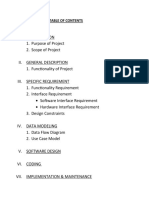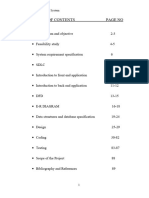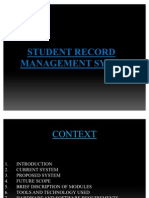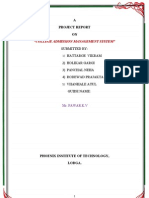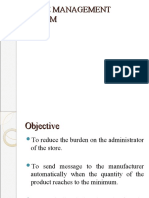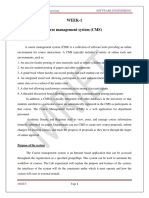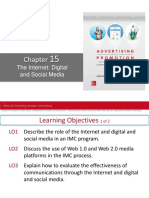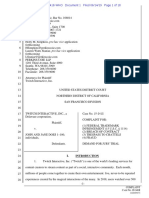Faculty Management Final Report
Faculty Management Final Report
Uploaded by
Bahubali HattiholiCopyright:
Available Formats
Faculty Management Final Report
Faculty Management Final Report
Uploaded by
Bahubali HattiholiOriginal Description:
Copyright
Available Formats
Share this document
Did you find this document useful?
Is this content inappropriate?
Copyright:
Available Formats
Faculty Management Final Report
Faculty Management Final Report
Uploaded by
Bahubali HattiholiCopyright:
Available Formats
MVT based Faculty Information, retrieval and reporting System 2019
CHAPTER 1:
INTRODUCTION
1.1 Introduction:
As the name specifies “MVT (Model View Template) based Faculty Information,
retrieval and reporting System” is an application developed for maintaining the faculty
information in any educational institution. Faculty Management System can be used by
educational institutes to maintain the records of Faculty with ease. Achieving this objective is
difficult using a manual system as the information is scattered, can be redundant and
collecting relevant information may be very time consuming. All these problems are solved
using this application. This application provides various functionalities for the faculties to
add, update and view their details.
1.2 Problem statement:
To design and develop “MVT based Faculty Information, retrieval and reporting
System” which automates the operations of maintaining faculty information in an educational
institute.
DEPARTMENT OF M.C.A, K.L.E.TECH HUBBALLI Page 1
MVT based Faculty Information, retrieval and reporting System 2019
CHAPTER 2:
LITERATURE SURVEY
The first step in system development life cycle is the identification of need of change
to improve or enhance an existing system. An initial investigation on existing system was
carried out. The present system for faculty is completely manual. Many problems were
identified during the initial study of the existing system. The existing system of has to be
computerized in order to overcome the problems which affect the existing system. The
limitations of the existing system are given below.
2.1 Existing System:
Existing system is manual, need lot of efforts and consumes time. In the existing
system admin adds the department and faculty details manually in the form of file records. It
may lead to loss of data and it is difficult to handle the data. The existing system does not
have any backup of records and there is no user authentication. It needs hierarchical level of
human work which requires more strength and more number of labours needed. The system
is a file record system and has more human interference, it leads to repetitive of the same
procedure. If any misplacement of files there is no backup for the data. Low Security is when
Unauthorised users may view and alter the data without any authentication which leads the
loss of data.
DEPARTMENT OF M.C.A, K.L.E.TECH HUBBALLI Page 2
MVT based Faculty Information, retrieval and reporting System 2019
2.2 Proposed System:
To overcome the drawback of the existing system the proposed system has been
evolved. This application aims to reduce the paper work and saves time in maintaining the
Faculty records. The system provides the best user interface. The proposed system is
designed in an organized manner. It occupies comparatively lesser space, so memory can be
organized in a proper way. The project aims in helping an educational institution to maintain
faculty information. This system provides the Admin HOD and Faculty to access the system
with unique their authentication. This procedure helps in high security where only valid users
can view and modify the related data. As there are different modules for different users, job
is easier to work as only respective user does the related work which reduces the human
power. As there is backup of data in the sever, data is secured. System helps faculty to update
the profile with login credentials anywhere and anytime, there is no need to visit the
administration office, search their profile and then update. This system is MVT based as
Model helps to create tables in a systematic way, Views helps to perform the functionalities
with a less line of code. Template provides the interface to the web application. If any new
functionalities to be added it is easy to add as there is a classification between Model, View
and Template.
Our proposed system has several Features:
Administrator has the power to add and view the department and respective
HOD’s.
Admin provides the login credentials (Username and Password) to the HOD’s.
HOD has the power to add and view the courses.
HOD has the power to add and view the faculties.
HOD provides the login credentials (Username and Password) to the faculties.
Faculty can update the personal details and change the password.
Faculty can add and update the details like qualifications, experience,
publications, workshops patents and grants.
DEPARTMENT OF M.C.A, K.L.E.TECH HUBBALLI Page 3
MVT based Faculty Information, retrieval and reporting System 2019
CHAPTER 3:
SYSTEM REQUIREMENT SPECIFICATIOIN
3.1 Introduction:
A system requirement specification is a document or set of documents that describe
the features and behaviour of the system or the software application. It includes a variety of
elements that attempts to define the customer to satisfy the different users.
3.2 Purpose:
The purpose of the SRS is to specify the requirements and to design the system and
validate the system.
3.3 Scope:
The project which is going to be presented in this document is called “MVT based
Faculty Information, retrieval and reporting System”. This application is planned to be used
by faculty members and authorities in an educational institution.
3.4 Software Requirements:
Operating System : Windows XP or any of its family
Scripting : Javascript, Python django framework
Front end : HTML 5, CSS3, Bootstrap framework
Tools used : PyCharm
Database : SQLite3
3.5 Hardware Requirements:
Processor : Core i3 or Higher
Primary Memory : 2gb RAM
Hard disk : 40gb disk space
DEPARTMENT OF M.C.A, K.L.E.TECH HUBBALLI Page 4
MVT based Faculty Information, retrieval and reporting System 2019
3.6 Definitions, Acronyms & abbreviations
*MVT : Model View Template.
*SRS : Software Requirement Specification
*HOD : Head of the Department
*FMS :Faculty Management System
3.7 Functional Requirements:
1: Admin:
Input:
*Username and Password.
Process:
*Username and password is verified.
Output:
*Admin Dashboard where he can add and view the department and
HOD’s.
2: HOD:
Input:
*Username and Password.
Process:
*Username and password is verified.
Output:
*HOD Dashboard where he can add and view the courses and
faculties.
DEPARTMENT OF M.C.A, K.L.E.TECH HUBBALLI Page 5
MVT based Faculty Information, retrieval and reporting System 2019
3: Faculty:
Input:
*Username and Password.
Process:
*Username and password is verified.
Output:
*Faculty Dashboard where he can add and update the details like
qualifications, experience, publications, workshops patents and grants.
3.8 Non-functional Requirements:
Security: Nobody should be allowed to tamper with data; Enhanced Security for
sensitive data. It should be made sure that only users who are given specific rights can
access data
Portability: The system should work on any of the modern browsers like Firefox,
chrome etc. and any of the common Operating Systems like Windows , Android etc.
Performance: The system should handle the simultaneous usage of almost 1000
users at a time.
Availability: System should be available at all times. System should ensure that data
is protected from unauthorized access.
DEPARTMENT OF M.C.A, K.L.E.TECH HUBBALLI Page 6
MVT based Faculty Information, retrieval and reporting System 2019
CHAPTER 4:
SYSTEM DESIGN
4.1 Architecture Design
ADMIN HOD FACULTY
GUI
Presentation Tier
Logic Tier
ADMIN LOGIN FACULTY LOGIN HOD LOGIN ADMIN ADD/VIEW
HOD
HOD ADD/VIEW FACULTY UPDATES PERSONAL
FACULTY AND OTHER DETAILS
Data Tier
DATABASE
Fig 4.1.1 Architecture Design of Result Management S/m
DEPARTMENT OF M.C.A, K.L.E.TECH HUBBALLI Page 7
MVT based Faculty Information, retrieval and reporting System 2019
4.2 Data Flow Diagram:
Data flow diagrams are a graphical tool used to describe and analyse the movement of
data through a system. DFD’s are used to capture the essential feature of both existing real
system and future physical implementation of the system.
The DFD is a technique that depicts the information flow and the transforms that are
applied as data move form input to output. The DFD is known as Bubble Chart or Data Flow
Graphs or Context diagram.
The data flow diagram may be used to present a system or software at any level of
abstraction. A functional system model or a context model represents the entire software
elements as a single bubble with input and output data indicated by incoming and outgoing
arrows respectively.
NOTATIONS:
1. Oval:
A process shows a transformation or manipulation of data flows within the system.
The symbol used is a rounded rectangle or oval.
2. Data Store:
A data store is a holding place for information within the system.It is represent By
An open ended narrow rectangle. Data store notation might. Refer to database tables or files.
3. Source Link:
DEPARTMENT OF M.C.A, K.L.E.TECH HUBBALLI Page 8
MVT based Faculty Information, retrieval and reporting System 2019
An external entity is a source or destination of a data flow which is outside the area of
study. The symbol used is a rectangle or square. Containing a meaningful and unique
identifier.
4. Data Flow:
A data flow shows the flow of information from its source to its destination. A data
flow is represented by a line, with arrowheads showing the direction of flow. Information
always flows to or from a process and may be written verbal or electronic. Each data flow
may be referenced by the processes or data stores at its head and tail, or by a description of its
contents. Data flow design is concerned with designing a sequence of functional
transformations that convert system inputs into the required output.
Data Flow Diagram:
Context level DFD:
DEPARTMENT OF M.C.A, K.L.E.TECH HUBBALLI Page 9
MVT based Faculty Information, retrieval and reporting System 2019
Detailed level DFD:
DEPARTMENT OF M.C.A, K.L.E.TECH HUBBALLI Page 10
MVT based Faculty Information, retrieval and reporting System 2019
4.3 Sequence Diagram
Figure 4.3.1 Admin
Figure 4.3.2: HOD
DEPARTMENT OF M.C.A, K.L.E.TECH HUBBALLI Page 11
MVT based Faculty Information, retrieval and reporting System 2019
Figure 4.3.3: Faculty
DEPARTMENT OF M.C.A, K.L.E.TECH HUBBALLI Page 12
MVT based Faculty Information, retrieval and reporting System 2019
4.4 Use Case Diagram:
Add /View
Departments
Add / View
HOD’s
Give Login
Admin Credentials
FMS
to HOD
Logs in
Add Faculty
Add Course
Give login
HOD Credentials FMS
to faculty
DEPARTMENT OF M.C.A, K.L.E.TECH HUBBALLI Page 13
MVT based Faculty Information, retrieval and reporting System 2019
Logs in
Add Personal
Details
Change
Password
Add
Workshops
Add
Qualifications
Add
Publications
Add Patents
Details
Faculty
Add Details of
Grants
Fetched
Add Details of
Grants
Applied
Add Details of
Awards/Appre
ciation
Add bank
Details
DEPARTMENT OF M.C.A, K.L.E.TECH HUBBALLI Page 14
MVT based Faculty Information, retrieval and reporting System 2019
4.5 ER-DIAGRAM:
DEPARTMENT OF M.C.A, K.L.E.TECH HUBBALLI Page 15
MVT based Faculty Information, retrieval and reporting System 2019
4.6 Database Design:
The term database design can be used to describe many different parts of the design of
an overall database system. Principally, and most correctly, it can be thought of as the logical
design of the database structures used to store the data. In the relational model, these are the
tables and views. In an object database are entities and relationships map directly to object
classes and named relationships. However, the term database design could also be used to
apply to the overall process of designing, not just the database structures, but also the forms
and queries used as part of the overall database application within the database management
system (DBMS).
staff_awardss_details:
staff_bachelorss_degree:
DEPARTMENT OF M.C.A, K.L.E.TECH HUBBALLI Page 16
MVT based Faculty Information, retrieval and reporting System 2019
staff_banks_details:
staff_courses_details:
staff_department:
DEPARTMENT OF M.C.A, K.L.E.TECH HUBBALLI Page 17
MVT based Faculty Information, retrieval and reporting System 2019
staff_hodregister:
staff_experiences_details:
DEPARTMENT OF M.C.A, K.L.E.TECH HUBBALLI Page 18
MVT based Faculty Information, retrieval and reporting System 2019
staff_facultydetails:
staff_grantss_applied:
DEPARTMENT OF M.C.A, K.L.E.TECH HUBBALLI Page 19
MVT based Faculty Information, retrieval and reporting System 2019
staff_grantss_fetched:
staff_masterss_degree:
DEPARTMENT OF M.C.A, K.L.E.TECH HUBBALLI Page 20
MVT based Faculty Information, retrieval and reporting System 2019
staff_patentss_details:
staff_personal_details:
DEPARTMENT OF M.C.A, K.L.E.TECH HUBBALLI Page 21
MVT based Faculty Information, retrieval and reporting System 2019
staff_phds_degree:
staff_publications_details:
DEPARTMENT OF M.C.A, K.L.E.TECH HUBBALLI Page 22
MVT based Faculty Information, retrieval and reporting System 2019
staff_workshops_details:
DEPARTMENT OF M.C.A, K.L.E.TECH HUBBALLI Page 23
MVT based Faculty Information, retrieval and reporting System 2019
CHAPTER 5
IMPLEMENTATION
5.1 Technology used:
Django
Django is a high-level Python web framework that helps to build rapid development
of secure and maintainable websites. Built by experienced developers, Django takes care of
much of the inconvenience of web development, so we can focus on writing our application. It
is free and open source, has a thriving and active community, great documentation, and
many options for free and paid-for support. Django is one of the top web development
languages. Its main goals are simplicity, flexibility, reliability, and scalability as shown
below.
Versatile
Django can be used to build almost any kind of website .It can work with any client-side
framework, and can deliver content in almost any format and it provides more functionality it
can also be extended to use other components if needed.
Secure
Django helps to avoid security all kind of security mistakes by providing Django
framework and it helps to protect the websites automatically. It provides user security means
setting password. Only authenticated person can access the web application with the help of
django.It provides secure way to manage user accounts.
Scalable
Django uses a component-based “shared-nothing” architecture (each part of the
architecture is independent of the others, and can hence be replaced or changed if needed).
Having a clear separation between the different parts means that it can scale for increased
traffic by adding hardware at any level: caching servers, database servers, or application
servers.
DEPARTMENT OF M.C.A, K.L.E.TECH HUBBALLI Page 24
MVT based Faculty Information, retrieval and reporting System 2019
Maintainable
Django code is written using design principles and patterns that encourage the creation of
maintainable and reusable code. Django also promotes the grouping of related functionality
into reusable "applications" and, at a lower level, groups related code into modules.Django is
compatible with all the projects irrespective of its size, whether it is small or big one. Because
of its scalability, it is ideal for startups and also serves extraordinary for sites with hundreds
of users a moment
Fast and Simple
It helps to simplify the work for developers for that reason the technology called Django
uses some of the principles as shown below
It follows DRY (Don’t Repeat Yourself) means it gives reusability function for the
existing code.
The iteration can be done more one time as it develops rapidly without taking from
scratch.
Python
Python is one of the popular, general purpose and high level programming languages. We
can use this high level programming language for developing desktop GUI applications,
websites and web application. Python allows us to focus on core functionality of the
application by taking care of common programming tasks. Python has simple syntax rules so it
is further makes easier to more readable and application maintainable.
Python supports several programming paradigm. It supports both object oriented and
structured programming. Python language features support various concepts in functional,
aspect-oriented programming, dynamic type system and also automatic memory management.
Thus it helps us to use python for developing large and complex software applications.
Python has large and robust library compared with other programming languages. We
can choose modules according to our precise needs. Each module enables us to add
functionality to the python application without writing additional code. Python is a general
purpose programming language, hence we can use it for developing both desktop and web
applications. It is also used for developing complex scientific and numeric applications. We
DEPARTMENT OF M.C.A, K.L.E.TECH HUBBALLI Page 25
MVT based Faculty Information, retrieval and reporting System 2019
can use python to create prototype of the application rapidly. Python has TDD approach i.e.
test driven development, hence it allows us to perform coding and testing simultaneously.
HTML
HTML means Hypertext Markup Language. HTML is a method of describing the
format of document, which allows them to be viewed on computer screen. Web browsers
display HTML documents, program which can navigate across networks and display a wide
variety of types of information. HTML pages can be developed to be simple text or to be
complex multimedia extra advantages containing, moving images, virtual reality, and java
applets.
HTML defines their appearance and layout and more importantly creates the links to
other documents.
HTML is a Major language of the Internet’s World Wide Web. Web sites and web
pages are written in HTML the World Wide Web is a collection of linked documents or
a pages on millions of computers spread over the entire Internet.
Databases
A Database in SQLite consists of a collection of tables that contain data and other
objects, such as views, indexes, stored procedures, and triggers, defined to support activities
performed with the data. The data stored in a database is usually related to a particular
subject or process, such as inventory information for a manufacturing warehouse.
SQLite server can support many databases. Each database can store either interrelated
or unrelated data from other databases. E.g. A Server can have one database that stores
personal data and another that stores product-related data.
5.2 Module explanation
Admin:
Administrator has the power to add and view the department and respective HOD’s.
Admin provides the login credentials (Username and Password) to the HOD’s.
DEPARTMENT OF M.C.A, K.L.E.TECH HUBBALLI Page 26
MVT based Faculty Information, retrieval and reporting System 2019
HOD:
HOD has the power to add and view the courses and faculties. Also provides the login
credentials (Username and Password) to the faculties.
Faculty:
Faculty can update the personal details and change the password. Can add and update
the details like qualifications, experience, publications, workshops, patents and grants.
5.3 SOURCE CODE:
Models:
class Department(models.Model):
name = models.CharField(max_length=100)
acronym = models.CharField(max_length=10)
code = models.CharField(max_length=100)
estd = models.DateTimeField()
location = models.CharField(max_length=100)
class hodregister (models.Model):
name = models.CharField(max_length=100)
email = models.EmailField()
department = models.CharField(max_length=100)
mobile = models.IntegerField()
designation = models.CharField(max_length=500)
user = models.ForeignKey(
User,on_delete=models.CASCADE,blank=True,null=True)
class Personal_Details(models.Model):
DEPARTMENT OF M.C.A, K.L.E.TECH HUBBALLI Page 27
MVT based Faculty Information, retrieval and reporting System 2019
firstname = models.CharField(max_length=100)
middlename = models.CharField(max_length=100)
lastname = models.CharField(max_length=100)
dateofbirth = models.DateField()
emailid = models.EmailField()
mobile = models.IntegerField()
alternatemobile = models.IntegerField()
aadharnumber = models.IntegerField()
pancardnumber = models.IntegerField()
bloodgroup = models.CharField(max_length=60)
street = models.CharField(max_length=200)
pincode = models.IntegerField()
city = models.CharField(max_length=200)
district = models.CharField(max_length=200)
state = models.CharField(max_length=200)
dateofjoining = models.DateField(max_length=200)
departmentname = models.CharField(max_length=200)
designation = models.CharField(max_length=200)
user = models.ForeignKey(User,on_delete=models.CASCADE)
created = models.DateTimeField(auto_now_add=True)
updated = models.DateTimeField(auto_now_add=True)
class Bachelorss_Degree (models.Model):
degreename = models.CharField(max_length=400)
collegename = models.CharField(max_length=400)
University = models.CharField(max_length=400)
yearofpassing = models.CharField(max_length=500)
result = models.CharField(max_length=600)
percentage = models.CharField(max_length=100)
DEPARTMENT OF M.C.A, K.L.E.TECH HUBBALLI Page 28
MVT based Faculty Information, retrieval and reporting System 2019
emailid = models.EmailField()
user = models.ForeignKey(User, on_delete=models.CASCADE)
created = models.DateTimeField(auto_now_add=True)
updated = models.DateTimeField(auto_now_add=True)
class Masterss_degree (models.Model):
degreename = models.CharField(max_length=400)
collegename = models.CharField(max_length=400)
University = models.CharField(max_length=400)
yearofpassing = models.CharField(max_length=500)
result = models.CharField(max_length=600)
percentage = models.CharField(max_length=100)
emailid = models.EmailField()
user = models.ForeignKey(User, on_delete=models.CASCADE)
created = models.DateTimeField(auto_now_add=True)
updated = models.DateTimeField(auto_now_add=True)
class Phds_Degree (models.Model):
degreename = models.CharField(max_length=400)
collegename = models.CharField(max_length=400)
University = models.CharField(max_length=400)
specification = models.CharField(max_length=500)
yearofpassing = models.CharField(max_length=500)
result = models.CharField(max_length=600)
percentage = models.CharField(max_length=100)
emailid = models.EmailField()
user = models.ForeignKey(User, on_delete=models.CASCADE)
created = models.DateTimeField(auto_now_add=True)
DEPARTMENT OF M.C.A, K.L.E.TECH HUBBALLI Page 29
MVT based Faculty Information, retrieval and reporting System 2019
updated = models.DateTimeField(auto_now_add=True)
class Experiences_Details (models.Model):
institutename = models.CharField(max_length=600)
joiningdate = models.DateField()
designation = models.CharField(max_length=600)
hikename = models.CharField(max_length=600)
scale = models.CharField(max_length=600)
enddate = models.DateField()
address = models.CharField(max_length=600)
state = models.CharField(max_length=600)
emailid = models.EmailField()
user = models.ForeignKey(User, on_delete=models.CASCADE)
created = models.DateTimeField(auto_now_add=True)
updated = models.DateTimeField(auto_now_add=True)
Views
def seen(request):
if request.method == 'GET':
return render(request, 'login4.html')
else:
validate_user = authenticate(
username=request.POST['username'],
password=request.POST['password'])
if validate_user:
login(request, validate_user)
return render(request, 'dashboard.html')
else:
messages.success(request, 'Invalid password!!')
return render(request, 'login4.html')
DEPARTMENT OF M.C.A, K.L.E.TECH HUBBALLI Page 30
MVT based Faculty Information, retrieval and reporting System 2019
def seener(request):
if request.method == 'GET':
return render(request, 'login6.html')
else:
validate_user = authenticate(
username=request.POST['username'],
password=request.POST['password'])
if validate_user:
login(request, validate_user)
return render(request, 'facultydashboard.html')
else:
messages.success(request, 'Invalid password!!')
return render(request, 'login6.html')
def seens(request):
if request.method == 'GET':
return render(request, 'login5.html')
else:
validate_user = authenticate(
username=request.POST['username'],
password=request.POST['password'])
if validate_user:
login(request, validate_user)
return render(request, 'dashboard2.html')
else:
messages.success(request, 'Invalid password!!')
return render(request, 'login5.html')
DEPARTMENT OF M.C.A, K.L.E.TECH HUBBALLI Page 31
MVT based Faculty Information, retrieval and reporting System 2019
# view to insert department in Admin dashboard
def insert_department(request):
if request.method == 'POST':
department_form = DepartmentForm(request.POST)
if department_form.is_valid():
post_department = department_form.save(commit=False)
post_department.save()
messages.success(request, 'Department Added SUCCESSFULLY!!')
return HttpResponseRedirect('/staff/adddept')
if request.method == 'GET':
return render(request, 'adddept.html')
def insert_hod(request):
if request.method == 'POST':
department_form = registerForm44(request.POST)
if department_form.is_valid():
new_user = User.objects.create_user(
username=request.POST['email'],
password=request.POST['password'])
post_department = department_form.save(commit=False)
post_department.user = new_user
post_department.save()
messages.success(request, 'HOD Added SUCCESSFULLY!!')
return HttpResponseRedirect('/staff/addhod')
if request.method == 'GET':
return render(request, 'addhod.html')
def depttview(request):
DEPARTMENT OF M.C.A, K.L.E.TECH HUBBALLI Page 32
MVT based Faculty Information, retrieval and reporting System 2019
if request.method == 'GET':
department = list(Department.objects.all())
return render(request, 'view.html',
{'staff': department})
def view_hod(request):
if request.method == 'GET':
queryset = hodregister.objects.filter(designation='HOD',
department='MCA').only("name", "department","email","mobile")
return render(request, 'viewhod.html',
{'staff': queryset})
URLs
from django.conf.urls import url
from django.contrib import admin
from django.urls import path, include
from staff import views
urlpatterns = [
url (r'^$',include('staff.urls'), name='staff'),
path('admin/', admin.site.urls),
url(r'^staff/', include('staff.urls'), name='staff'),
]
Template – Login:
<body>
<div class="container">
<div class="jumbotron" style="margin-top:5%;">
<div class="row justify-content-md-center">
<img src="{% static 'img/logo.png' %}" alt="">
</div>
DEPARTMENT OF M.C.A, K.L.E.TECH HUBBALLI Page 33
MVT based Faculty Information, retrieval and reporting System 2019
<br>
<div class="row justify-content-md-center">
<div class="col-sm-3">
<div class="form-group">
{% if messages %}
<ul class="messages">
{% for message in messages %}
<li>
<div class="alert alert-warning">
{{message}}
</div>
</li>
{% endfor %}
</ul>
{% endif %}
</div>
<form method="POST">
{% csrf_token %}
<a href="{% url 'homee' %}"> <img src="{% static 'img/s.jpg' %}"
alt="Error" class="img2"> </a>
<h3>Admin Login Here</h3>
<div class="form-group">
<label for="email">Email address:</label>
<input type="email" class="form-control" name="username" id="email"
required>
</div>
<div class="form-group">
<label for="pwd">Password:</label>
DEPARTMENT OF M.C.A, K.L.E.TECH HUBBALLI Page 34
MVT based Faculty Information, retrieval and reporting System 2019
<input type="password" class="form-control" name="password" id="pwd"
required>
</div>
<div class="form-group form-check">
<label>
<a href="#">Forgot Password</a>
</label>
</div>
<button type="submit" class="btn btn-primary">Submit</button>
</form>
</div>
</div>
</div>
</div>
</body>
DEPARTMENT OF M.C.A, K.L.E.TECH HUBBALLI Page 35
MVT based Faculty Information, retrieval and reporting System 2019
Chapter 6
TESTING AND RESULT
Test Cases:
Software testing is an investigation conducted to provide stakeholders with
information about the quality of the product or service under test. Software testing can also
provide an objective, independent view of the software to allow the business to appreciate
and understand the risks of the software implementation.
Software testing can be stated as the process of validating and verifying that a
computer program meets the requirements that guided its design and development,
application works as expected, product can be implemented with the same characteristics and
satisfies the needs of customers.
Sl. No Case Input Expected Actual References
Output Output
1. Admin Username and Admin Admin Figure 1
Login(valid) Password Dashboard Dashboard
2. Admin When user Display error Display error Figure 2
Login(Invalid) tries to login message message
with invalid
credentials
3. HOD Username and HOD HOD Figure 3
Login(valid) Password Dashboard Dashboard
4. HOD When user Display error Display error Figure 4
Login(Invalid) tries to login message message
with invalid
credentials
DEPARTMENT OF M.C.A, K.L.E.TECH HUBBALLI Page 36
MVT based Faculty Information, retrieval and reporting System 2019
5. Faculty Username and Faculty Faculty Figure 5
Login(valid) Password Dashboard Dashboard
6. Faculty When user Display error Display error Figure 6
Login(Invalid) tries to login message message
with invalid
credentials
Two types of testing:
1. White box testing (also known as clear box testing, glass box testing and transparent-
box testing and structural testing)
2. Black box testing: Treats the software as a “black box”, examining functionality
without any knowledge of internal implementation. It is also known as Release
testing, functional testing. This method of test can be applied to software testing: unit,
integration, system and acceptance.
Unit testing:
Unit testing, also known as component testing refers to tests that verify the
functionality of a specific section of code, usually at the function level. IN an object-oriented
environment, this is usually at the class level, and the minimal unit tests include the
constructors and destructors. Depending on the organizations expectations for software
development, unit testing might include static code analysis and other software verification
practices.
System testing:
System testing tests a completely integrated system to verify that it meets its
requirements. The concern of this testing is to check the behaviour of the whole system as
defined by the scope of the project. The main concern of system testing is to verify the
system against the specified requirements. While carrying out the test, the one who tests is
not concerned with the internal of the system, but checks if the system behaves as per
expectations.
DEPARTMENT OF M.C.A, K.L.E.TECH HUBBALLI Page 37
MVT based Faculty Information, retrieval and reporting System 2019
Test report:
Performance
The application will be developed with a intension of providing the system that is
highly interactive and takes less time and maintains the faculty information properly.
Scalability
Application will be flexible enough to include the resources, any changes with dataset
will be reflected in functionality.
Availability
Once the system is deployed the system will be available to the users if you are
connected.
Reliability
Reliability ensures that system will not fail to perform its intended functions. Any
sudden changes will be handled in programming concept.
Usability
This application is very easy for usage. Environment is built user friendly. No
complications are seen in the system.
DEPARTMENT OF M.C.A, K.L.E.TECH HUBBALLI Page 38
MVT based Faculty Information, retrieval and reporting System 2019
CONCLUSION
The project is based on the requirement specification of the user and the analysis of
the existing system, with flexibility for future enhancement. The expanded functionality
of today’s software requires an appropriate approach towards software development.
System allows to add the faculty records and maintain the faculty records. It gives the
functionality for the faculties like adding publications details, adding workshops details
and by using this application faculty can apply leave.
This application is designed for the Faculty Information Management and performing
and maintaining the related functionalities. The administrator has the power of adding,
viewing and removing the faculty records.
DEPARTMENT OF M.C.A, K.L.E.TECH HUBBALLI Page 39
MVT based Faculty Information, retrieval and reporting System 2019
FUTURE ENHANCEMENT
This application can be used as Android Mobile application for more
convenience.
The SMS notification feature will be added.
RPA(Robotic Process Automation) Technology to be added in order to fetch
the academic details of the faculty members directly from scanned copies to
avoid the human mistakes
DEPARTMENT OF M.C.A, K.L.E.TECH HUBBALLI Page 40
MVT based Faculty Information, retrieval and reporting System 2019
BIBILIOGRAPHY
Books Referred:
[1] Ian Somerville “Software Engineering”, 6th Edition, Pearson Publication, USA
2006.
[2] Pankaj Jalote “An Integrated Approach to Software Engineering”, 2nd Edition,
Narosa Publishing House, India 2005.
Websites Referred:
[1]https://www.w3schools.com/howto/howto_css_responsive_form.asp(This
link is used to create responsive form using CSS)
[2] https://docs.djangoproject.com/en/2.2/(This link is used to Develop the
Django Application)
DEPARTMENT OF M.C.A, K.L.E.TECH HUBBALLI Page 41
MVT based Faculty Information, retrieval and reporting System 2019
USER MANUAL
Admin Dashboard :
Figure 1
Admin Login Error:
Figure 2
DEPARTMENT OF M.C.A, K.L.E.TECH HUBBALLI Page 42
MVT based Faculty Information, retrieval and reporting System 2019
HOD Dashboard:
Figure 3
HOD Login Error:
Figure 4
DEPARTMENT OF M.C.A, K.L.E.TECH HUBBALLI Page 43
MVT based Faculty Information, retrieval and reporting System 2019
Faculty Dashboard:
Figure 5
HOD Login Error:
Figure 6
DEPARTMENT OF M.C.A, K.L.E.TECH HUBBALLI Page 44
You might also like
- The Basics of Drishti: A Free-To-Download Volume Exploration & Presentation ToolDocument37 pagesThe Basics of Drishti: A Free-To-Download Volume Exploration & Presentation ToolBailey Lovett100% (10)
- AZ-204 Exam Questions With Aswers LatestDocument34 pagesAZ-204 Exam Questions With Aswers LatestRohit Parchure100% (2)
- Documentation of Course Registration SystemDocument19 pagesDocumentation of Course Registration SystemDeepak Sharma83% (6)
- Employee Management System: L. N. Mishra College of Business ManagementDocument56 pagesEmployee Management System: L. N. Mishra College of Business ManagementSaurav ShauryaNo ratings yet
- Client Server Architecture A Complete Guide - 2020 EditionFrom EverandClient Server Architecture A Complete Guide - 2020 EditionNo ratings yet
- College Management SystemDocument78 pagesCollege Management Systemindia bharatNo ratings yet
- Synopsis On NCC Management SystemDocument6 pagesSynopsis On NCC Management Systemarun kaushikNo ratings yet
- Institute Management SystemDocument18 pagesInstitute Management Systemrmarwani67% (3)
- PGDCADocument7 pagesPGDCAAnonymous l5X3VhTNo ratings yet
- Project Report 4th SemDocument21 pagesProject Report 4th Semshiv.regkec-991-21No ratings yet
- Collage Management SystemDocument7 pagesCollage Management System28bhavik1992No ratings yet
- Institute Management System Using Java Project ReportDocument60 pagesInstitute Management System Using Java Project ReportlkNo ratings yet
- 138-College Management System - SynopsisDocument6 pages138-College Management System - SynopsismcaprojectsNo ratings yet
- Hostel ManagementDocument20 pagesHostel ManagementSahil KumarNo ratings yet
- College Management SystemDocument8 pagesCollege Management SystemSunil Sharma50% (2)
- Dairy Management SystemDocument43 pagesDairy Management SystemSnegha MathiNo ratings yet
- Project Report Banking ManagemeDocument88 pagesProject Report Banking ManagemeMd SharidNo ratings yet
- WTA Mini Project FormatDocument21 pagesWTA Mini Project FormatIfra100% (3)
- Projectreport 121202043850 Phpapp02Document120 pagesProjectreport 121202043850 Phpapp02Narayan LokeNo ratings yet
- Student Information Management System Project Report IIDocument63 pagesStudent Information Management System Project Report IIKamal AcharyaNo ratings yet
- A Project Report ON Coaching Management SystemDocument66 pagesA Project Report ON Coaching Management SystemRainee KocharNo ratings yet
- Report of Student Management SystemDocument49 pagesReport of Student Management SystemKunal BangarNo ratings yet
- AI-Based Picture Translation App: 1) Background/ Problem StatementDocument7 pagesAI-Based Picture Translation App: 1) Background/ Problem Statementtejas patilNo ratings yet
- ATM Project ReportDocument26 pagesATM Project ReportSaurav VivekNo ratings yet
- Online Rto Management System PDFDocument87 pagesOnline Rto Management System PDFAjit More100% (3)
- Bca SynopsisDocument22 pagesBca SynopsisCaptain HarshNo ratings yet
- Online Notes Sharing System: A Project Report ONDocument8 pagesOnline Notes Sharing System: A Project Report ONGazala AnamNo ratings yet
- Synopsis Student Result Management SystemDocument2 pagesSynopsis Student Result Management SystemPratik ShirodkarNo ratings yet
- Attendance AndroidDocument29 pagesAttendance Androidtanmay gawdeNo ratings yet
- Student Record Managment SynopsisDocument16 pagesStudent Record Managment Synopsishahahaha67% (3)
- Angular POC ProjectDocument35 pagesAngular POC Projectsagar BoleNo ratings yet
- "College Admission Management System": A Project Report ONDocument20 pages"College Admission Management System": A Project Report ONmukundmgkNo ratings yet
- Major Project REPORTDocument42 pagesMajor Project REPORTGurvinder SinghNo ratings yet
- Store Management System Project 29092013023847 Store Management System ProjectDocument50 pagesStore Management System Project 29092013023847 Store Management System Projectasawari bhaskar kumbhar100% (1)
- A PROJECT REPORT On Online Examination SystemDocument53 pagesA PROJECT REPORT On Online Examination SystemMizanur AlrasidNo ratings yet
- Internet Tools and Web TechnologyDocument91 pagesInternet Tools and Web TechnologyYashwant SinghNo ratings yet
- Cyber Cafe Management PDFDocument37 pagesCyber Cafe Management PDFMalathi palanisamyNo ratings yet
- Courier Management System Project ReportDocument58 pagesCourier Management System Project ReportKamal AcharyaNo ratings yet
- A Project Report On "Payroll Management System "Document25 pagesA Project Report On "Payroll Management System "harsh talpadaNo ratings yet
- Online Discussion Project ReportDocument75 pagesOnline Discussion Project Reportashley0% (1)
- Ooad Record AbinashDocument241 pagesOoad Record AbinashRAM KUMAR SNo ratings yet
- Project Report1Document154 pagesProject Report1RohitJoshiNo ratings yet
- Online Library Management System: Mini Project Report OnDocument30 pagesOnline Library Management System: Mini Project Report OnRavikumar KhilariNo ratings yet
- College Management System ProjectDocument66 pagesCollege Management System ProjectManish RajputNo ratings yet
- College Hostel Management SystemDocument32 pagesCollege Hostel Management SystemSHASHI BHAN MAURYANo ratings yet
- coLLEGE Management SystemDocument7 pagescoLLEGE Management Systemzainab zainabNo ratings yet
- ProjectDocument14 pagesProjectBommineni Sri PavaniNo ratings yet
- A Project Report ON Campus Recruitment SystemDocument31 pagesA Project Report ON Campus Recruitment SystemYash DobariyaNo ratings yet
- Employee Leave Management System Project ReportDocument91 pagesEmployee Leave Management System Project Report007Ãrnav SinghaNo ratings yet
- College e EeeeeeeDocument102 pagesCollege e EeeeeeeSandeep KumarNo ratings yet
- Dbms Project ReportDocument18 pagesDbms Project ReportD.SameerNo ratings yet
- Online Evaluation System: Project Report OnDocument49 pagesOnline Evaluation System: Project Report Onnixon tjNo ratings yet
- Flight FRNT BcaDocument62 pagesFlight FRNT BcaPrints BindingsNo ratings yet
- Online Examination SystemDocument84 pagesOnline Examination SystemMukeshNo ratings yet
- Maharishi University of Information Technology LUCKNOW (UP) - 226013Document77 pagesMaharishi University of Information Technology LUCKNOW (UP) - 226013Suraj DubeyNo ratings yet
- A Project Report ON: "Deparmental Storage Management System "Document19 pagesA Project Report ON: "Deparmental Storage Management System "manhar pratapNo ratings yet
- Mad ppt-4Document15 pagesMad ppt-4Anjali M GowdaNo ratings yet
- Online Car TradingDocument6 pagesOnline Car TradingVijayAVjNo ratings yet
- Department Management System - Web-Based ApplicationDocument7 pagesDepartment Management System - Web-Based ApplicationR. SubuNo ratings yet
- WEEK-1 Course Management System (CMS) : Computer Science and EngineeringDocument18 pagesWEEK-1 Course Management System (CMS) : Computer Science and EngineeringDrkmkrNo ratings yet
- IJSRD - International Journal For Scientific Research & Development - Vol. 8, Issue 3, 2020 - ISSN (Online) - 2321-0613Document3 pagesIJSRD - International Journal For Scientific Research & Development - Vol. 8, Issue 3, 2020 - ISSN (Online) - 2321-0613Rockey DudeNo ratings yet
- Srs For Mobile Attendance SystemsDocument8 pagesSrs For Mobile Attendance Systemsnive ramesh100% (1)
- Internet Marketing or Modern Advertising! How? Why?: International Journal of Economy, Management and Social SciencesDocument8 pagesInternet Marketing or Modern Advertising! How? Why?: International Journal of Economy, Management and Social SciencesMorteza MoghaddamNo ratings yet
- Freelance Graphic & Web Designer ResumeDocument2 pagesFreelance Graphic & Web Designer ResumeMohsin MarediaNo ratings yet
- A Project ReportDocument48 pagesA Project ReportDEEPALI BAGULNo ratings yet
- Empowerment TechnologyDocument4 pagesEmpowerment TechnologyTapnio Glezel GolongNo ratings yet
- Fa19m2bd017 - SRS IubDocument13 pagesFa19m2bd017 - SRS IubHammad BhaiNo ratings yet
- Lokesh - 2023 02 20 065932Document2 pagesLokesh - 2023 02 20 065932POLINENI LOKESHNo ratings yet
- Howto Webservers PDFDocument12 pagesHowto Webservers PDFPlesa AlexandruNo ratings yet
- Web Based "Project Management" Using: Peter WielandDocument24 pagesWeb Based "Project Management" Using: Peter WielandgigioaNo ratings yet
- The Internet: Digital and Social MediaDocument43 pagesThe Internet: Digital and Social MediaSalma M. ElghanamNo ratings yet
- Oral Com Reviewer q2Document10 pagesOral Com Reviewer q2Danica Vera Joy Valdez-DuroNo ratings yet
- RM ProjectDocument29 pagesRM Project084 UjwalaNo ratings yet
- Wordpress Create A Website or Blog SyllabusDocument4 pagesWordpress Create A Website or Blog Syllabusbahmadzai738No ratings yet
- The 5 Secrets To Becoming A Drupal 7 Ninja Shane Thomas 2014 Diypromo PDFDocument206 pagesThe 5 Secrets To Becoming A Drupal 7 Ninja Shane Thomas 2014 Diypromo PDFJoseph KayimaNo ratings yet
- Module 7 NotesDocument4 pagesModule 7 NotesSummer Kieth KingsNo ratings yet
- r20 IV I Full Stack DevelopmentDocument131 pagesr20 IV I Full Stack Developmentsanjaykumartiwari28975No ratings yet
- Hinged Spoon Rest TutorialDocument6 pagesHinged Spoon Rest TutorialNicolas FiumaraNo ratings yet
- Web Design ModuleDocument9 pagesWeb Design Moduleapi-712235401No ratings yet
- Online Job Portal DocumentationDocument71 pagesOnline Job Portal Documentationmohammed Biratu100% (1)
- InformationDocument2 pagesInformationravis.reddy7629No ratings yet
- Twitch v. John Doe 1-100Document29 pagesTwitch v. John Doe 1-100Gizmodo EditNo ratings yet
- Agency Onboarding GuideDocument25 pagesAgency Onboarding GuideheymuraliNo ratings yet
- CV Rodrigo-EspinosaDocument4 pagesCV Rodrigo-EspinosaRodrigo EspinosaNo ratings yet
- Affiliate MarketingDocument22 pagesAffiliate MarketingDelkhaSumenepNo ratings yet
- Bac4624 - Assignment - Q - T2 2019-20 3Document7 pagesBac4624 - Assignment - Q - T2 2019-20 3joyitNo ratings yet
- Web Client Configuration Guide (For Microsoft IIS Web Server)Document54 pagesWeb Client Configuration Guide (For Microsoft IIS Web Server)Rachit PathakNo ratings yet
- Presentation Creative PlatformsDocument10 pagesPresentation Creative PlatformsdphotoportsmouthNo ratings yet
- Empowerment Technology Module 1_pptDocument81 pagesEmpowerment Technology Module 1_pptJepe Talidong NardoNo ratings yet
- Rulebook Asme HPVC PDFDocument34 pagesRulebook Asme HPVC PDFDave ShahNo ratings yet


